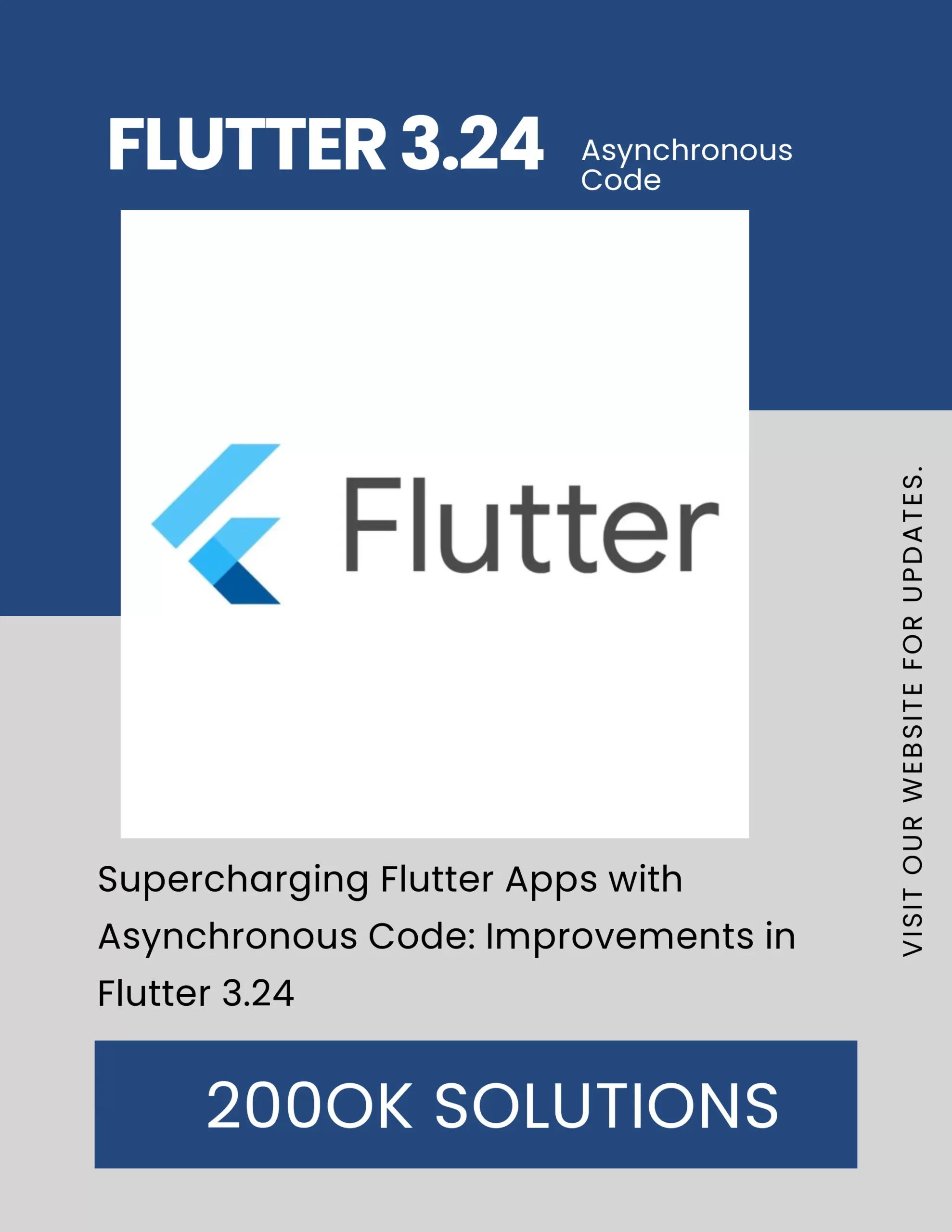Flutter 3.24 has introduced several exciting enhancements to its asynchronous programming model, which is vital for handling tasks such as network requests, file I/O, and database queries without blocking the UI. In this blog post, we’ll dive into the asynchronous code improvements in Flutter 3.24, exploring what’s new, how it works, and why it matters for your app development process.
1. Enhanced Stream and Future Handling in Flutter 3.24
In Flutter 3.24, there’s better performance for handling Future and Stream objects, which are essential for managing asynchronous events such as real-time data updates and background tasks.
a. Optimized Future Scheduling
When dealing with Future in Dart, the event loop can become overwhelmed with multiple asynchronous operations, causing slowdowns in complex applications. Flutter 3.24 improves the way Futures are scheduled and resolved, leading to more efficient resource management. For example, previously, when a Future was completed, there could be some delays before the next task was picked up by the event loop, especially when a heavy UI or computation load was running. In 3.24, the improved event loop management reduces these delays, making sure that tasks are processed as soon as they’re available without affecting the app’s UI performance.
b. Stream Enhancements
Streams allow apps to handle continuous data flows, such as real-time updates from a server or user-generated events. In Flutter 3.24, Stream performance has been optimized to ensure that real-time data processing is smoother and more predictable. This is particularly useful in scenarios like live data feeds, chats, or financial applications where latency and responsiveness are critical.
Example: Efficient Stream Handling
Stream<int> numberStream() async* {
for (int i = 0; i < 10; i++) {
await Future.delayed(Duration(seconds: 1));
yield i;
}
}
void handleStream() {
numberStream().listen((number) {
print('New number: $number');
});In Flutter 3.24, the performance improvements ensure that handling multiple streams like this won’t overwhelm the event loop or cause noticeable performance drops, even in more intensive scenarios.
2. Improved Error Handling in Asynchronous Code
In Flutter 3.24, there’s an enhancement in error handling when dealing with asynchronous operations. Previously, developers had to be very cautious about handling exceptions in async/await code, as uncaught exceptions could crash the app or lead to subtle bugs. Now, error propagation in asynchronous code is more predictable, making it easier to handle exceptions in Futures or Streams in a non-blocking and non-crashing way. You can now safely catch and handle errors in the asynchronous code paths without compromising app stability.
Example: Improved Error Handling
Future<void> fetchData() async {
try {
var response = await http.get(Uri.parse('https://example.com/data'));
if (response.statusCode == 200) {
print('Data: ${response.body}');
} else {
throw Exception('Failed to load data');
}
} catch (e) {
print('Error: $e');
}
}
Flutter 3.24 ensures that such error handling is robust, and the app doesn’t crash due to an unhandled exception. Additionally, these improvements extend to handling exceptions in streams, making your app more resilient when processing real-time data.
3. Concurrency with Isolates: Easier and Faster Background Tasks
Flutter and Dart use isolates for parallel processing to keep heavy computation off the main thread. In Flutter 3.24, there are improvements in how isolates handle message passing, which makes background tasks even faster and more reliable. This is especially useful when performing CPU-intensive tasks like image processing, encryption, or data parsing without freezing the UI.
Example: Using Isolates
import 'dart:isolate';
// Function to perform heavy computation
void heavyTask(SendPort sendPort) {
int result = 0;
for (int i = 0; i < 1000000000; i++) {
result += i;
}
sendPort.send(result);
}
void runHeavyTask() async {
ReceivePort receivePort = ReceivePort();
await Isolate.spawn(heavyTask, receivePort.sendPort);
receivePort.listen((data) {
print('Heavy task result: $data');
});
} Previously, managing communication between isolates could introduce latency or complexity, but Flutter 3.24 optimizes this process, allowing for smoother inter-isolate communication and reducing overhead.
4. Async-Aware Widgets: Smoother Loading States
Flutter 3.24 brings improvements to how asynchronous data is handled within widgets. For example, the use of FutureBuilder and StreamBuilder has become more efficient with better synchronization with the framework’s state management. The widgets are now more optimized for rebuilds and state transitions, especially when dealing with multiple asynchronous operations that might update parts of the UI at different times. This ensures smoother and more predictable UI updates without unnecessary rebuilds, which improves app performance.
Example: Async-Aware UI with FutureBuilder
class AsyncDataWidget extends StatelessWidget {
Future<String> fetchData() async {
await Future.delayed(Duration(seconds: 2));
return "Data loaded!";
}
@override
Widget build(BuildContext context) {
return FutureBuilder<String>(
future: fetchData(),
builder: (context, snapshot) {
if (snapshot.connectionState == ConnectionState.waiting) {
return CircularProgressIndicator();
} else if (snapshot.hasError) {
return Text('Error: ${snapshot.error}');
} else {
return Text('Result: ${snapshot.data}');
}
},
);
}
}In Flutter 3.24, FutureBuilder is more optimized to prevent unnecessary widget rebuilds when asynchronous data is loading or updating, leading to smoother UI performance.
5. Concurrency with async/await: More Predictable Execution
Flutter 3.24 improves the internal mechanics of Dart’s async/await operations to ensure that execution of asynchronous code is even more predictable and less prone to race conditions or deadlocks. These changes may not be visible at first glance, but they reduce potential issues in complex asynchronous workflows. For example, when making a series of dependent async calls, Flutter 3.24 ensures that the state is maintained properly and avoids timing issues where operations could be completed out of order.
Conclusion: Why Asynchronous Code Improvements in Flutter 3.24 Matter
The asynchronous code improvements in Flutter 3.24 are a significant step forward in making Flutter apps faster, more responsive, and easier to maintain. By enhancing the performance of Futures, Streams, isolates, and async-aware widgets, Flutter 3.24 ensures that developers can handle complex, asynchronous tasks with minimal performance overhead. Whether you’re dealing with real-time data, heavy computations, or network requests, Flutter 3.24’s optimizations allow you to build apps that remain smooth and responsive, even under heavy load.
For more information, check out the official resources:


